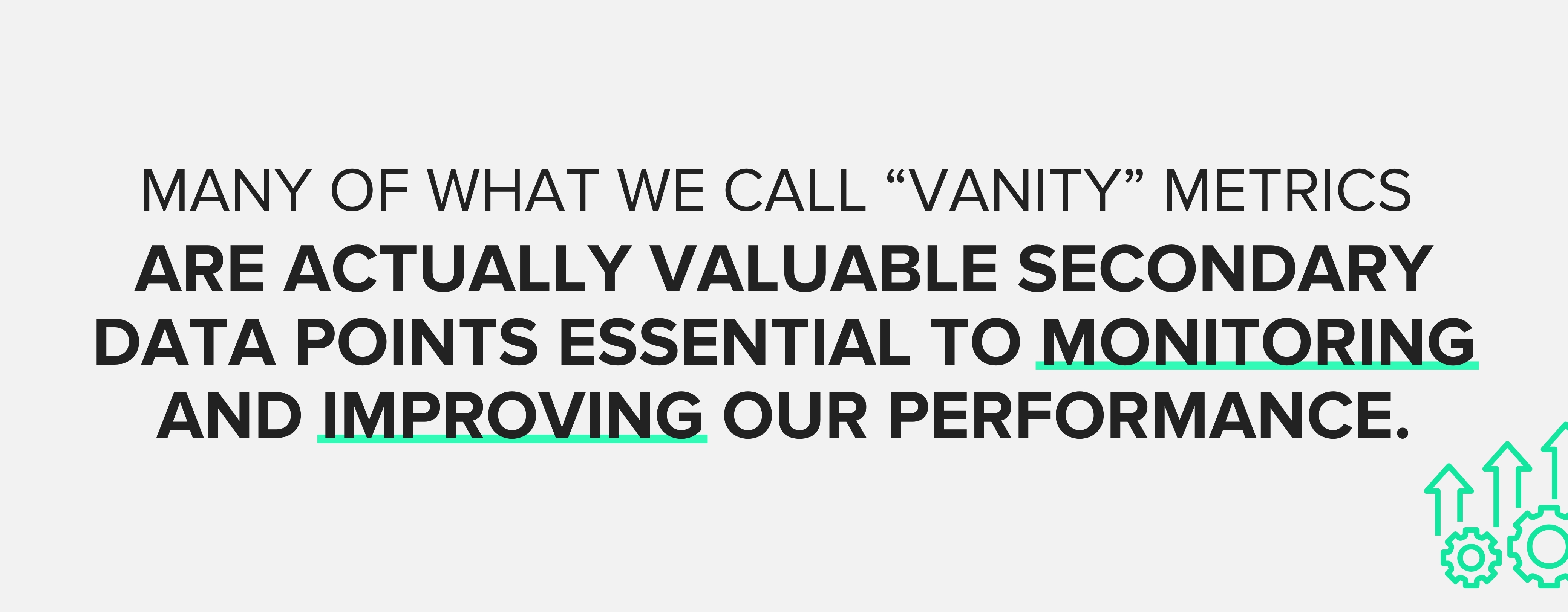Topics:
Reporting & PerformanceSubscribe now and get the latest podcast releases delivered straight to your inbox.
Vanity Metrics Are The Most Misunderstood Numbers in Marketing

Dec 26, 2022

In recent years, the phrase “vanity metrics” has become a bit of a misnomer; a label we throw at any data we deem as not important or just don’t like.
Views on TikTok? Vanity metric.
Visits to that fluffy article you wrote five years ago? Vanity metric.

But this is in poor practice.
In reality, vanity metrics are numbers that look and sound impressive, but don’t directly say anything about how you're performing on your goals.
In other words, they’re metrics without context or connection to what you’re trying to accomplish.
Both TikTok views and visits to a fluffy article could be vanity metrics, but they could also be key metrics depending on your goal at hand.
The point is this: Sure, seeing numbers hit a high may be exciting, but if they don’t translate to conversions, revenue, or whatever you’re trying to do, do they matter?

If you have 10,000 people visiting your consultation page every day, but none are filling out the form, are those views really worth celebrating?
Many of what we call “vanity” metrics are actually valuable secondary data points essential to monitoring and improving our performance (more on that later), but true vanity metrics can prove dangerous to your greater goals.
The key to navigating this danger is knowing how to spot a true vanity metric and avoid it.
What are vanity metrics?
True vanity metrics, like the name suggests, are superficial.
They’re so vain, they probably think your campaign is about them.
Sorry. I couldn’t resist.
But honestly, these are the flashy numbers you can barely resist bragging about.
They grab attention, but they don’t necessarily indicate anything about your company's deeper health and what you're trying to accomplish.
For example, leads generated from an eBook no longer related to what you offer is a vanity metric, or traffic to your careers page when you’re not hiring.
What you consider a “vanity metric” may change over time, but one thing about them will always stay true — you can’t let them distract from your primary goals.
In 2014, Brian Balfour, Founder/CEO at Reforge (and former VP of Growth at HubSpot), argued that many teams are too heavily focused on vanity metrics.
Businesses get caught up in the excitement of seeing numbers going up and the metrics that actually reflect their growth and profitability get neglected.
Nearly a decade later, the problem is alive and well. Tech valuations and investments, for instance, are heavily decided on user numbers and ad sales on views.
It’s only human, really.
Celebrating vanity metrics can promote the wrong success
Let’s say you set up a LinkedIn ad to generate new leads. You see the number of clicks on the ad skyrocket and you get excited.
Endorphins hit, your team is happy, you may even get some external recognition, and you think you hit the nail on the head.
The emotional reward of a vanity metric conditions marketers to want more. This way, we can easily lose focus of the bigger picture — or in this case, the bigger metrics that actually matter.
Riding high, you do everything you can to repeat this success — ignoring where your critical numbers actually stand.
As a business, this pattern is something you need to be wary of and ensure doesn’t get out of hand.
Find the ‘north star’ for your data
When Balfour was at HubSpot, the growth team monitored a number of different metrics, but ultimately, they all led back to what he called their “north star:” Weekly Active Users (WAU).
And this made this sense.
As a software or app, having new registrants, downloads, or free trial users are important numbers, but they are ultimately meaningless if those people don't become users of the app.
Say you have 15,000 users, but only 1,000 open the app daily. Yes, you can publicize, celebrate, and reward having 15,000 users, but at the end of the day, 14,000 of those are not invested enough to use your app every day (or most likely, pay for it.) They won’t help you grow.

With all of this in mind, WAU became HubSpot's most important metric. Its north star to follow.
The metrics you celebrate should reflect your goals — what you ultimately want to accomplish.
If HubSpot was going to grow revenue, it needed more paying customers and WAU would help get them there. If you sell a product, your main focus/metric may be the number of units sold in a day. If you’re a service, maybe it’s your monthly revenue.
Regardless of your specific end goal, the north star is where your team needs to keep its eyes. That is the metric you should celebrate and reward for achieving.
However, that doesn’t mean you throw all your “vanity” metrics out.
Many ‘vanity metrics' are actually supporting characters in your success story
Let’s go back to our ad example for a minute.
If the clicks on your ad are climbing, you’re not wrong for being excited.
In an ideal world, more traffic means more people on your website hopefully converting — which may be your primary goal.
Traffic may not be your main focus in this case, but it’s not a vanity metric either. It is a secondary metric, a supporting character in your success story.
Secondary metrics like these are numbers you monitor and track as leading indicators of how your efforts are unfolding. They can help you better predict your progress toward your primary metric/goal and help you understand what’s working and what’s not:
Clicks on your ad low? Clearly your ad creative needs some work.
Clicks high but few people are converting when they reach the page? Your ad’s doing the job, but your page is missing something.
If your leads numbers aren’t increasing, your secondary numbers can help you dig deeper and give you a better idea of how to pivot to get back on track.
Not so vain after all, right?
Not all vanity metrics are created equal
Truth is, not all of the metrics we call “vanity metrics” are villains distracting us from our goal in our success story. Many of them are actually secondary metrics there to help us reach our greater goals.
The key here is understanding what metrics are actually in vain and which simply need more context.
As our Chief Strategy Officer Chris Duprey has said, “Context is what ties a number back to reality. Without context, numbers lack meaning. Even big ones like revenue and profitability can seem more impressive than they are if they’re not considered in context of other things.”
Overall, your company needs to contextualize its metrics that most effectively illustrate what your goals are, while also making it easy to determine when progress has been made or needs to be made.
Primary or secondary, if the metrics you track accomplish this and consistently help you move towards your goal, your team will know where to focus its efforts, and just as importantly, they’ll know when it’s actually time to celebrate.


Order Your Copy of Marcus Sheridan's New Book — Endless Customers!